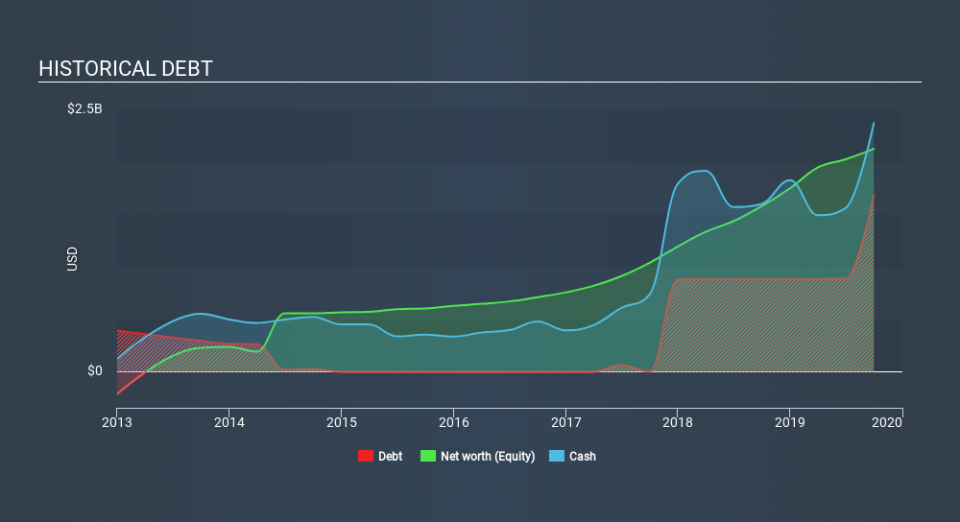Weibo (NASDAQ:WB) Seems To Use Debt Rather Sparingly

Howard Marks put it nicely when he said that, rather than worrying about share price volatility, 'The possibility of permanent loss is the risk I worry about... and every practical investor I know worries about. So it seems the smart money knows that debt - which is usually involved in bankruptcies - is a very important factor, when you assess how risky a company is. We note that Weibo Corporation (NASDAQ:WB) does have debt on its balance sheet. But the real question is whether this debt is making the company risky.
Why Does Debt Bring Risk?
Debt assists a business until the business has trouble paying it off, either with new capital or with free cash flow. If things get really bad, the lenders can take control of the business. However, a more usual (but still expensive) situation is where a company must dilute shareholders at a cheap share price simply to get debt under control. Of course, plenty of companies use debt to fund growth, without any negative consequences. When we think about a company's use of debt, we first look at cash and debt together.
View our latest analysis for Weibo
What Is Weibo's Debt?
The image below, which you can click on for greater detail, shows that at September 2019 Weibo had debt of US$1.68b, up from US$883.1m in one year. However, it does have US$2.37b in cash offsetting this, leading to net cash of US$693.8m.
A Look At Weibo's Liabilities
Zooming in on the latest balance sheet data, we can see that Weibo had liabilities of US$778.7m due within 12 months and liabilities of US$1.70b due beyond that. Offsetting these obligations, it had cash of US$2.37b as well as receivables valued at US$827.5m due within 12 months. So it can boast US$719.5m more liquid assets than total liabilities.
This surplus suggests that Weibo has a conservative balance sheet, and could probably eliminate its debt without much difficulty. Succinctly put, Weibo boasts net cash, so it's fair to say it does not have a heavy debt load!
The good news is that Weibo has increased its EBIT by 8.2% over twelve months, which should ease any concerns about debt repayment. The balance sheet is clearly the area to focus on when you are analysing debt. But ultimately the future profitability of the business will decide if Weibo can strengthen its balance sheet over time. So if you want to see what the professionals think, you might find this free report on analyst profit forecasts to be interesting.
Finally, a company can only pay off debt with cold hard cash, not accounting profits. While Weibo has net cash on its balance sheet, it's still worth taking a look at its ability to convert earnings before interest and tax (EBIT) to free cash flow, to help us understand how quickly it is building (or eroding) that cash balance. Over the last three years, Weibo recorded free cash flow worth a fulsome 90% of its EBIT, which is stronger than we'd usually expect. That positions it well to pay down debt if desirable to do so.
Summing up
While we empathize with investors who find debt concerning, you should keep in mind that Weibo has net cash of US$693.8m, as well as more liquid assets than liabilities. And it impressed us with free cash flow of US$452m, being 90% of its EBIT. So we don't think Weibo's use of debt is risky. Over time, share prices tend to follow earnings per share, so if you're interested in Weibo, you may well want to click here to check an interactive graph of its earnings per share history.
When all is said and done, sometimes its easier to focus on companies that don't even need debt. Readers can access a list of growth stocks with zero net debt 100% free, right now.
If you spot an error that warrants correction, please contact the editor at editorial-team@simplywallst.com. This article by Simply Wall St is general in nature. It does not constitute a recommendation to buy or sell any stock, and does not take account of your objectives, or your financial situation. Simply Wall St has no position in the stocks mentioned.
We aim to bring you long-term focused research analysis driven by fundamental data. Note that our analysis may not factor in the latest price-sensitive company announcements or qualitative material. Thank you for reading.

 Yahoo Finance
Yahoo Finance 
